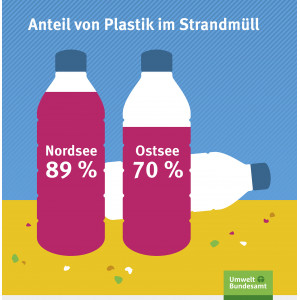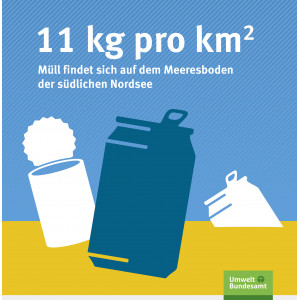An initiative led by Federal Environment Minister Dr. Barbara Hendricks, Lower Saxony State Minister for Environment Stefan Wenzel, and President Maria Krautzberger of the German Environment Agency established the Round Table Against Marine Litter in March 2016. The round table aims to develop measures to counteract further pollution of the oceans and to raise broad public awareness of the problem and the need for action.
The round table works along the guidelines of the Marine Strategy Framework Directive which states that marine litter may not cause harm. The participants develop recommendations for action to combat marine litter. The results of several marine monitoring projects shed light on the extent of the problem: 400 pieces of litter were found along a 100-metre stretch of beach on the North Sea, 70 pieces along the same length of a beach on the Baltic Sea – more than 70 per cent of which is plastic. An average eleven kilograms of waste per square kilometre is on the floor of the southern North Sea – again, mostly plastic. Finally, almost all the northern fulmars found along Germany’s North Sea beaches had ingested plastic in their stomach.
The working groups of the Round Table submitted an interim report of all their results today. The report contains a survey of all the entry pathways of plastic waste and microplastics into the oceans as well as recommendations on how the topic of marine litter can be integrated into school lesson plans. An example of a measure to combat marine litter is the Fishing for Litter initiative which involves distributing large bags to commercial fisheries in which to collect the waste which is caught in their nets to then be transported to ports. The project is also meant to raise awareness among the fishermen and be integrated as a training module at the vocational school for commercial fishers in Rendsburg. The Round Table will prove an ideal platform for exchange and mutual support.
Federal Environment Minister Barbara Hendricks said: “The Round Table Against Marine Litter has emerged as an active and broad-based network which has noticeably helped in recent months to further raise awareness and has already launched many campaigns at the local level. Policy-makers now have a strong adviser and admonisher to help solve the marine litter problem.”
Stefan Wenzel, Lower Saxony State Minister for Environment, said: “As patron of the working group on marine litter, I am very glad that one agreed measure has been implemented. The working group has drafted a recommendation for the optimisation of port reception facilities which aims to reduce the pollution of the seas. This recommendation will be examined in the talks on the revision of the European Port Reception Facilities Directive. What distinguishes this recommendation is that it was jointly drafted by experts from environmental associations, the shipping industry, port authorities and operators, the plastics industry and everyone else involved in the working group."
Maria Krautzberger, President of the German Environment Agency (UBA), said: "Plastic litter can be found everywhere in our oceans – on shorelines, in the water, in fish and seabirds. Plastic enters the oceans via many different pathways. Our research has shown that large plastic parts are the major source of microplastics. Every plastic cup, every drinking straw and every plastic bag which is discarded and decomposes in the environment is complicating the problem. We must be more vigilant about how we handle plastic. One way to help is to set up additional deposit/return systems which include among others reusable dishes or styrofoam fish boxes."
The Round Table Against Marine Litter hosts representatives from various industries including shipping and fishing, plastics, wastewater management, cosmetics, tyres, the retail trade, science, authorities at the federal, Land and municipal level, tourism, environmental associations and artists.
 Click to enlarge
Click to enlarge





